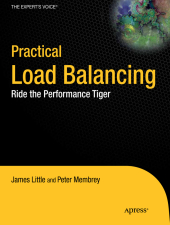 Neuerscheinungen 2012Stand: 2020-01-07 |
Schnellsuche
ISBN/Stichwort/Autor
|
Herderstraße 10
10625 Berlin
Tel.: 030 315 714 16
Fax 030 315 714 14
info@buchspektrum.de |

David Hows, Peter Membrey, Eelco Plugge
(Beteiligte)
Practical Load Balancing
Ride the Performance Tiger
1st ed. 2012. xiv, 272 S. XIV, 272 p. 254 mm
Verlag/Jahr: SPRINGER, BERLIN; APRESS 2012
ISBN: 1-430-23680-9 (1430236809)
Neue ISBN: 978-1-430-23680-1 (9781430236801)
Preis und Lieferzeit: Bitte klicken
The emergence of the cloud and modern, fast corporate networks demands that you perform judicious balancing of computational loads. Practical Load Balancing presents an entire analytical framework to increase performance not just of one machine, but of your entire infrastructure.
Practical Load Balancing starts by introducing key concepts and the tools youŽll need to tackle your load-balancing issues. YouŽll travel through the IP layers and learn how they can create increased network traffic for you. YouŽll see how to account for persistence and state, and how you can judge the performance of scheduling algorithms.
YouŽll then learn how to avoid performance degradation and any risk of the sudden disappearance of a service on a server. If youŽre concerned with running your load balancer for an entire network, youŽll find out how to set up your network topography, and condense each topographical variety into recipes that will serve you in different situations. YouŽll also learn about individual servers, and load balancers that can perform cookie insertion or improve your SSL throughput.
YouŽll also explore load balancing in the modern context of the cloud. While load balancers need to be configured for high availability once the conditions on the network have been created, modern load balancing has found its way into the cloud, where good balancing is vital for the very functioning of the cloud, and where IPv6 is becoming ever more important.
You can read Practical Load Balancing from end to end or out of sequence, and indeed, if there are individual topics that interest you, you can pick up this book and work through it once you have read the first three chapters.
Part I: Getting Started
1. Introduction
2. How websites work: what makes them slow
3. Content Caching: keeping the load light
4. DNS based load balancing
5. Content Delivery Networks
6. Planning for Performance and Reliability
Part II: Load Balancing Essentials
7. Essential concepts you need to know
8. HTTP load balancing
9. Database load balancing
10. Load balancing your network connection
11. SSL Load Balancing
Part III: Load balancing situations
12. Clustering the Load Balancers for High Availability
13. Load balancing in the cloud
14. IPv6: Implications and concepts
15. Where to go next...
Appendix 1: Common Terms and Concepts
Hailing from the U.K., Peter Membrey has worked for Red Hat, holds a RHCE certification, and worked and taught at a number of educational institutions since the beginning of his career. He knows what Linux users like and need, and hopes that CentOS will get the kudos it deserves. He lives in Hong Kong and is teaching and consulting on all matters to do with Linux Enterprise networking, while studying for his masterŽs degree.


